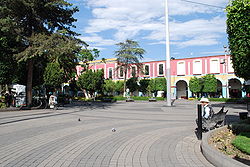
Uploaded on 2016-07-31 by Edgar Antonio Valdés Porras
Urban Heat Island in Mexico City Urban Heat Island (UHI) may be regarded as on of the major problems in the 21st century; it came as result of urbanization and industrialization. This phenomenon relates the large amount of heat generated from urban structures, as they consume and re-radiate solar radiations, and the anthropogenic heat sources as the main causes of UHI. The two heat sources increase the temperatures of an urban area as compared to its surroundings, which is known as Urban Heat Island Intensity (UHII). With the increment of temperature serious health issues arose which may cause an increment of deaths on the peak days in certain locations. The report by the climate central accounts for the summer temperature measure of 60 largest cities on the USA. Most important results are: on average, the maximum single day temperature difference was 17.5 °F and 2.4 °F hotter than the rural cities. On the conclusion it states that is very difficult to determine the impact of the urbanization footprint since the differences in regions and the unique constant changing of the landscape of each city. However suggestions –based on documentations- are made in the urban planning and design by incorporating more green areas, white rooftops and the use of alternative materials. In Mexico City, the UHI is actually an intense phenomenon –according to Oseguera and Barradas, 2014-. By measuring 8 °C difference between urban residential areas -delegación Alvaro Obregón- with respect a close rural area -Texcoco- . Affectations, in my opinion, came from the increasing density of population –as an anthropogenic heat source, whereas urban structures contribute less since the amount of available construction and free space is still enormous on this city; making the reflection effects non-significant. Based on the previous a control on population distribution in Mexico City can become a helpful tool. This could be realized by stablishing a zoning demand making more affordable the services and living in low dense populated areas. According to Mexico Academic initiative on climate change (PINCC-UNAM); a severe problem on the water distribution can be a factor to take in account on the temperature raising events. Mexico city has also made available a general law concerning climate change (LA LEY DE MITIGACIÓN Y ADAPTACIÓN AL CAMBIO CLIMÁTICO Y DESARROLLO SUSTENTABLE PARA EL DISTRITO FEDERAL) which mainly states recommendations on the popular knowledge regarding environmental issues. Not a systematic approach or long term plan is redacted on this law.